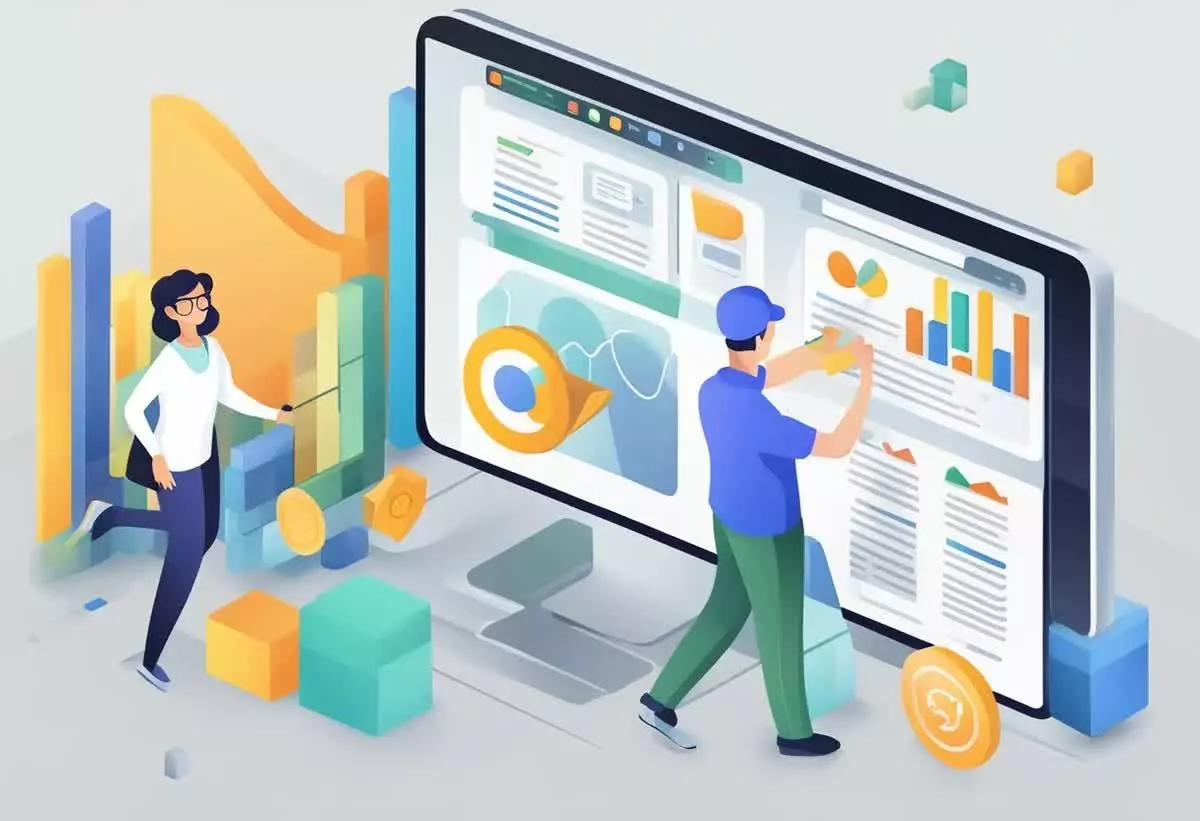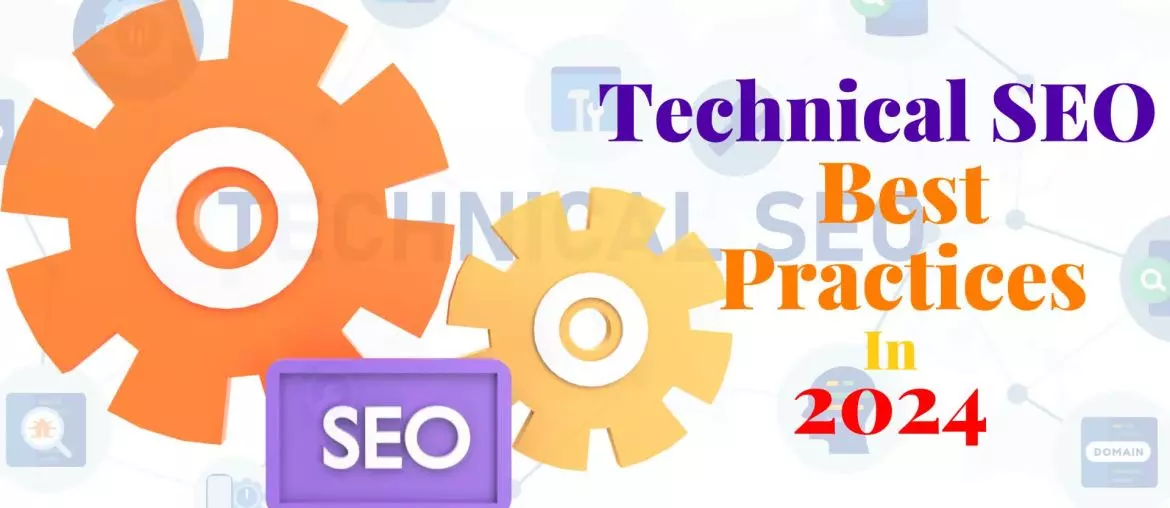Technical SEO best practices are essential for any website that wants to rank well in search engines. Technical SEO refers to the optimization of a website’s technical elements, such as site architecture, page speed, and crawlability, to improve its visibility and ranking in search engine results pages (SERPs).
One of the key technical SEO best practices is to ensure that a website has a clear and intuitive site architecture and URL structure that allows search engine crawlers to easily navigate and index the site’s pages. Another important aspect of technical SEO is page speed optimization, which involves optimizing a site’s code, images, and other elements to ensure that pages load quickly and efficiently.
Mobile-friendly design is also crucial for technical SEO, as search engines prioritize mobile-friendly sites in their rankings. Additionally, a secure and accessible website, high-quality and relevant content, structured data and schema markup, and effective monitoring and reporting are all important elements of technical SEO best practices.
Key Takeaways
- Technical SEO best practices involve optimizing a website’s technical elements to improve its visibility and ranking in search engine results pages.
- Key technical SEO best practices include site architecture and URL structure, page speed optimization, and mobile-friendly design.
- Other important aspects of technical SEO include ensuring a secure and accessible website, high-quality and relevant content, structured data and schema markup, and effective monitoring and reporting.
Site Architecture and URL Structure

Optimizing URL Slugs
URL slugs are the part of the URL that comes after the domain name and directory structure. It’s important to make sure that your URL slugs are concise, descriptive, and include relevant keywords. Avoid using generic slugs like “page” or “post” and use hyphens to separate words instead of underscores or spaces.
For example, instead of using a URL slug like “www.example.com/page=123”, use a more descriptive and keyword-rich slug like “www.example.com/technical-seo-best-practices”.
Breadcrumb Navigation
Breadcrumb navigation is a type of secondary navigation that displays the user’s current location on the website. It’s important for both user experience and SEO. Breadcrumb navigation helps users easily navigate your website and also helps search engines understand the structure of your website.
Make sure that your breadcrumb navigation is easy to use and understand. Use structured data to mark up your breadcrumb navigation so that search engines can understand it.
XML Sitemaps
XML sitemaps are files that list all of the pages on your website that you want search engines to crawl and index. They’re important because they help search engines discover pages on your website that they might not have found otherwise.
Make sure that your XML sitemap is up-to-date and includes all of the pages on your website that you want to be indexed. Submit your XML sitemap to search engines like Google and Bing to help them discover your pages faster.
Following these best practices for site architecture and URL structure can help improve your website’s crawlability and indexability, which can ultimately lead to better search engine rankings.
Page Speed Optimization

Leveraging Browser Caching
Leveraging browser caching means specifying how long web browsers should keep resources such as images, CSS files, and JavaScript files in their cache. By doing this, the browser will not need to download these resources each time a user visits your site, resulting in faster page load times.
To leverage browser caching, you can add cache-control headers to your website’s server. This can be done by adding code to your website’s .htaccess file or by using a caching plugin if you’re using a CMS like WordPress.
Minifying Resources
Minifying resources involves removing unnecessary characters such as whitespace, comments, and formatting from your website’s code. Doing this can reduce the file size of your pages, resulting in faster load times.
You can use tools such as YUI Compressor, UglifyJS, or Google’s Closure Compiler to minify your website’s resources.
Image Optimization
Images can significantly slow down your website’s load times if they are not optimized correctly. To optimize images, you can compress them to reduce their file size without compromising their quality.
You can use tools such as TinyPNG, Kraken.io, or ImageOptim to compress your website’s images. Additionally, you can specify image dimensions and use responsive images to ensure that your website’s images are appropriately sized for different devices.
By implementing these best practices for page speed optimization, you can significantly improve your website’s load times, resulting in a better user experience and higher search engine rankings.
Mobile-Friendly Design

Responsive Web Design
Responsive web design is a design approach that aims to provide an optimal viewing experience across all devices. With responsive design, the website’s layout and content adjust automatically to fit the screen size of the device being used. This means that users can access the same content on their desktop, tablet, or mobile device without sacrificing the user experience.
From an SEO perspective, responsive web design is preferred over other design approaches because it allows you to maintain a single URL for your website. This makes it easier for search engines to crawl and index your website. Additionally, having a single URL means that all the backlinks to your website will point to the same URL, which can help improve your website’s authority and ranking.
Accelerated Mobile Pages (AMP)
Accelerated Mobile Pages (AMP) is an open-source project that aims to improve the mobile browsing experience by providing fast-loading web pages. AMP pages are stripped down versions of regular HTML pages that are optimized for speed. They are designed to load instantly, providing a better user experience for mobile users.
From an SEO perspective, AMP can help improve your website’s visibility on mobile search results. Google has been pushing for faster and more mobile-friendly websites, and AMP is one of the ways they are encouraging website owners to make their websites more mobile-friendly. Additionally, AMP pages are given priority in Google’s mobile search results, which can help improve your website’s visibility and click-through rate.
In conclusion, having a mobile-friendly website is essential for Technical SEO. Responsive web design and Accelerated Mobile Pages (AMP) are two key components of mobile-friendly design that can help improve your website’s user experience and visibility on mobile search results.
Secure and Accessible Website
 Implementing HTTPS
Implementing HTTPS
One of the most important technical SEO best practices is to ensure that your website is secure. One way to do this is to implement HTTPS, which is a secure version of HTTP. HTTPS encrypts the data that is transmitted between the user’s browser and the website, making it more difficult for hackers to intercept and steal sensitive information.
To implement HTTPS, you need to obtain an SSL (Secure Sockets Layer) certificate. There are different types of SSL certificates available, including free and paid options. Once you obtain an SSL certificate, you need to install it on your web server and configure your website to use HTTPS instead of HTTP. This involves updating your website’s URLs and ensuring that all internal links and resources are also using HTTPS.
By implementing HTTPS, you not only improve the security of your website but also signal to search engines that your website is trustworthy and safe for users to visit.
Creating an Accessible Site
Another important aspect of technical SEO is creating an accessible website. Accessibility refers to the practice of making your website usable by people with disabilities, such as visual impairments and hearing loss. By creating an accessible website, you not only improve the user experience for people with disabilities, but you also improve the overall usability of your website.
Some best practices for creating an accessible website include using descriptive alt text for images, providing captions and transcripts for videos and audio content, and ensuring that your website is navigable using only a keyboard. You can also use tools such as screen readers and text-to-speech software to test the accessibility of your website.
In addition to improving the user experience for people with disabilities, creating an accessible website can also improve your website’s SEO performance. Search engines prioritize websites that are accessible and user-friendly, so by implementing accessibility best practices, you can improve your website’s search engine rankings and attract more organic traffic.
Overall, implementing HTTPS and creating an accessible website are two important technical SEO best practices that can improve the security, usability, and SEO performance of your website.
Content Quality and Relevance

Duplicate Content Issues
Duplicate content can have a negative impact on your website’s search engine rankings. When search engines encounter duplicate content, they may have difficulty determining which version of the content to index and rank. This can lead to a decrease in search engine visibility and traffic.
To avoid duplicate content issues, it is important to ensure that every piece of content on your website is unique. This can be achieved by conducting regular content audits and removing any duplicate content. Additionally, using canonical tags can help inform search engines which version of the content to prioritize.
Content Freshness
Search engines prioritize fresh and up-to-date content. Therefore, it is important to regularly update your website’s content to ensure that it remains relevant and informative. This can be achieved by creating a content calendar and regularly publishing new content.
Additionally, updating existing content can also help improve your website’s search engine rankings. This can be done by adding new information, updating statistics, and including new images or videos.
In conclusion, creating high-quality and relevant content is essential for improving your website’s search engine visibility and traffic. By avoiding duplicate content issues and regularly updating your content, you can ensure that your website remains competitive in the search engine rankings.
Structured Data and Schema Markup

Schema markup is a type of structured data that uses a set of agreed-upon definitions for microdata tags. It is the most commonly used approach to structured data markup for SEO purposes. Some websites use other vocabularies, such as Microformats.org, but Schema.org is the most widely recognized and supported by search engines.
Implementing schema markup on a website can help improve its visibility in search engine results pages (SERPs). This is because search engines use schema markup to show rich results, which are more engaging for searchers than regular search results. Rich results can include information such as reviews, ratings, and images, which can help improve click-through rates.
There are various types of schema markup that can be used depending on the type of content on a website. For example, a website that sells products can use product schema markup to provide information such as product name, description, price, and availability. A website that publishes articles can use article schema markup to provide information such as article title, author, date published, and article body.
In summary, structured data and schema markup are critical components of technical SEO. They help search engines to understand the content on a website accurately. Implementing schema markup on a website can help improve its visibility in search engine results pages and increase click-through rates.
Crawlability and Indexation

Robots.txt File
The robots.txt file is a text file that tells search engine crawlers which pages or sections of your website they should or should not crawl. This file is located in the root directory of your website, and it is essential to ensure that it is correctly configured to avoid blocking search engine crawlers from accessing important pages on your website.
Canonical Tags
Canonical tags are HTML tags that tell search engines which version of a page is the preferred version to index. This is particularly important when you have multiple versions of the same page, such as when you have a mobile version and a desktop version of your website. By using canonical tags, you can consolidate your page authority and avoid duplicate content issues.
Pagination and Multilingual SEO
If your website has a lot of content, you may need to use pagination to break up your content into smaller, more manageable pages. When using pagination, it is important to ensure that search engines can crawl and index all of your pages correctly. Additionally, if you have a multilingual website, it is essential to use hreflang tags to indicate to search engines which version of your content is intended for which language or region.
In summary, crawlability and indexation are critical aspects of technical SEO that can have a significant impact on your website’s search engine visibility. By following best practices such as correctly configuring your robots.txt file, using canonical tags, and ensuring that your pagination and multilingual SEO are correctly implemented, you can help ensure that your website is easily crawlable and indexable by search engines.
Core Web Vitals

There are three Core Web Vitals that website owners and developers should focus on:
- Largest Contentful Paint (LCP): This metric measures how long it takes for the largest content element on a page to load. A good LCP score is less than 2.5 seconds. To improve LCP, website owners and developers should optimize images and videos, reduce server response time, and remove unnecessary third-party scripts.
- First Input Delay (FID): This metric measures the time it takes for a website to respond to a user’s first interaction. A good FID score is less than 100 milliseconds. To improve FID, website owners and developers should minimize JavaScript execution time, optimize CSS, and use a content delivery network (CDN).
- Cumulative Layout Shift (CLS): This metric measures the visual stability of a page as it loads. A good CLS score is less than 0.1. To improve CLS, website owners and developers should avoid inserting non-visible content above the fold, reserve space for ads, and use size attributes for images and videos.
It is important for website owners and developers to regularly monitor and optimize their website’s Core Web Vitals. Google has provided a set of tools to help website owners and developers measure, monitor, and optimize their website’s Core Web Vitals. These tools include PageSpeed Insights, Lighthouse, and the Core Web Vitals report in Google Search Console.
By optimizing their website’s Core Web Vitals, website owners and developers can improve the user experience of their website, which can lead to higher search rankings and increased user engagement.
Server and Hosting Optimization

1. Choose a Reliable Web Host
The choice of web host can have a significant impact on website speed, uptime, and overall performance. It is essential to choose a reliable web host that offers fast and secure servers with high uptime. A web host that provides a Content Delivery Network (CDN) can also help in improving website speed and performance.
2. Enable Gzip Compression
Gzip compression is a technique that compresses website files before they are sent to the user’s browser. This can significantly reduce the size of files and improve website speed. Enabling Gzip compression on the server can help in improving website speed and performance.
3. Use a Fast DNS Provider
The Domain Name System (DNS) is responsible for translating domain names into IP addresses. A slow DNS provider can significantly impact website speed and performance. It is essential to choose a fast DNS provider that can quickly resolve domain names into IP addresses.
4. Optimize Server Response Time
The server response time is the time taken by the server to respond to a user’s request. A slow server response time can negatively impact website speed and performance. Optimizing server response time by reducing the size of website files, enabling caching, and using a Content Delivery Network (CDN) can help in improving website speed and performance.
5. Use HTTPS
Using HTTPS instead of HTTP can help in improving website security and SEO. HTTPS is a secure version of HTTP that encrypts data between the user’s browser and the web server. Google has also stated that HTTPS is a ranking signal, which means that websites using HTTPS may have a slight advantage in search engine rankings.
By following these best practices for server and hosting optimization, website owners can significantly improve website speed, performance, and SEO.
Monitoring and Reporting

Google Search Console
Google Search Console is a free tool that provides website owners with valuable insights into how Google crawls and indexes their websites. It allows users to monitor their website’s performance, identify technical issues, and optimize their website for search engines.
Some of the key features of Google Search Console include:
- Performance reports that provide insights into how your website is performing in Google search results.
- Index coverage reports that show which pages of your website are indexed by Google and which ones are not.
- URL inspection tool that allows you to check the status of individual pages on your website.
By regularly monitoring Google Search Console, website owners can identify and fix technical issues that may be affecting their website’s performance in search results.
Google Analytics 4
Google Analytics 4 is the latest version of Google’s web analytics platform. It provides website owners with valuable insights into how users interact with their websites. It allows users to monitor their website’s performance, identify technical issues, and optimize their website for search engines.
Some of the key features of Google Analytics 4 include:
- Enhanced measurement capabilities that allow for better tracking of user behaviour across devices and platforms.
- Integration with Google Ads that allows for better tracking of ad performance.
- Advanced machine learning capabilities that provide insights into user behaviour and website performance.
By regularly monitoring Google Analytics 4, website owners can identify and fix technical issues that may be affecting their website’s performance in search results.
Site Audits
Site audits are a crucial tool for monitoring and reporting technical SEO. They allow website owners to identify and fix technical issues that may be affecting their website’s performance in search results.
Some of the key features of site audits include:
- Identification of technical issues such as broken links, duplicate content, and missing meta tags.
- Analysis of website performance metrics such as page load speed and mobile-friendliness.
- Customizable reports that provide website owners with actionable insights into how to improve their website’s technical SEO.
By regularly conducting site audits, website owners can identify and fix technical issues before they have a negative impact on their website’s performance in search results.
Conclusion
In conclusion, technical SEO is a crucial aspect of any website’s optimization strategy. By following the best practices outlined in this article, website owners can ensure that their website is easily crawlable, indexable, and understandable by search engines like Google.
One of the most important best practices for technical SEO is to ensure that the website’s architecture is well-structured and easy to navigate. This can be achieved by creating a clear hierarchy of pages and using descriptive URLs that include relevant keywords.
Another important aspect of technical SEO is to optimize the website’s load speed. This can be done by minimizing the size of images and other media files, compressing code, and leveraging browser caching.
Website owners should also ensure that their website is mobile-friendly and responsive to different screen sizes. This can be achieved by using a responsive design or by creating a separate mobile version of the website.
Finally, website owners should regularly monitor their website’s performance and make adjustments as needed. This can be done by using tools like Google Analytics to track website traffic and user behaviour.
By following these best practices, website owners can improve their website’s search engine rankings and provide a better user experience for their visitors.
Frequently Asked Questions
What are the essential elements to include in a technical SEO checklist?
A technical SEO checklist should include various elements such as website speed, mobile responsiveness, site architecture, URL structure, internal linking, XML sitemap, robots.txt file, canonical tags, hreflang tags, structured data markup, and HTTPS security. These elements are essential for website optimization and should be checked regularly to maintain a website’s technical SEO health.
How does technical SEO differ from on-page SEO and why are both important?
Technical SEO and on-page SEO are two different aspects of search engine optimization. Technical SEO focuses on the technical aspects of a website such as site speed, site architecture, and URL structure. On-page SEO, on the other hand, deals with the content and optimization of individual web pages.
Both technical SEO and on-page SEO are important for website optimization. Technical SEO ensures that the website is structured in a way that is easy for search engines to crawl and index. On-page SEO ensures that the content on each page is optimized for the target keywords and provides value to the user.
What are the key factors to consider when optimizing a website’s technical SEO?
The key factors to consider when optimizing a website’s technical SEO include website speed, mobile responsiveness, site architecture, URL structure, internal linking, XML sitemap, robots.txt file, canonical tags, hreflang tags, structured data markup, and HTTPS security. All of these factors play a crucial role in website optimization and should be optimized regularly to ensure a website’s technical SEO health.
Why is technical SEO critical for a website’s search engine ranking?
Technical SEO is critical for a website’s search engine ranking because it ensures that the website is structured in a way that is easy for search engines to crawl and index. If a website is not optimized for technical SEO, search engines may have difficulty crawling and indexing the website, which can lead to poor search engine rankings.
What steps should be taken to ensure a website adheres to technical SEO best practices?
To ensure a website adheres to technical SEO best practices, website owners should regularly check their website for issues related to website speed, mobile responsiveness, site architecture, URL structure, internal linking, XML sitemap, robots.txt file, canonical tags, hreflang tags, structured data markup, and HTTPS security. Any issues should be addressed promptly to ensure a website’s technical SEO health.
What are the three pillars of technical SEO and how do they impact website performance?
The three pillars of technical SEO are crawlability, indexability, and site performance. Crawlability refers to the ability of search engines to crawl a website’s pages. Indexability refers to the ability of search engines to index a website’s pages. Site performance refers to the speed and responsiveness of a website.
All three pillars of technical SEO are important for website performance. If a website is not crawlable or indexable, search engines may have difficulty ranking the website. If a website has poor site performance, users may have difficulty accessing the website, which can lead to a poor user experience.
- The Importance of Local SEO for Small Businesses and How an Agency Can Help - 26 April 2024
- Ultimate Guide to Content Marketing for Accountants: Strategies, Tips & Examples - 23 February 2024
- Social Media Marketing For Accountants | 2Stallions - 22 February 2024
 Singapore
Singapore  Singapore
Singapore Malaysia
Malaysia




 Implementing HTTPS
Implementing HTTPS


Comments are closed.